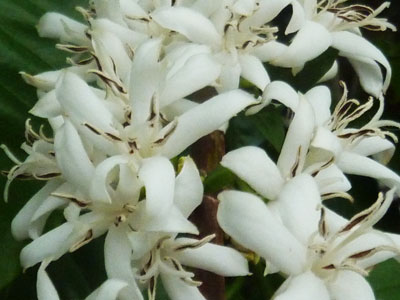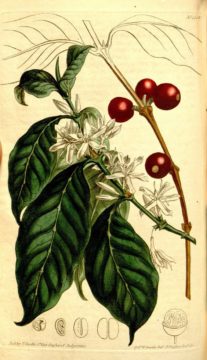FAMILY: RUBIACEAE
$100 pesos (small plant)
COFFEE: Tonic, stimulant, diuretic. A recent Harvard Medical School study has shown that women who drink coffee have a 70% less risk of committing suicide. On the other hand, Goethe blamed his habitual caffè latte for his chronic melancholia and depression. They didn’t say anything about men, but spiders who are sprayed with caffeine weave distorted webs. Also note that Spiders never sleep, with or without coffee. If you’re tired of drinking coffee bean extract, try the leaves. Three leaves boiled in a cup of water for 10 minutes make a nice stimulant tea.

The plants that we sell are seedlings of a tree originally grown from fresh coffee beans from Chiapas.
Something I’ve learned since moving here to Puerto Vallarta and being able to grow producing coffee trees is that the coffee “cherries,” the red fruit that contains the coffee “bean” is a very powerful source of caffeine. One or two of these cherries is equivalent (for me) to about 1 cup of brewed coffee). They taste good, also, although the taste is nothing like roasted coffee. It is more of a fruity/nutty flavor.
This — eating fresh coffee cherries — is probably the most compelling reason why anyone who likes coffee should grow a tree. Here in Vallarta, the seeds start ripening in August and continue on and off thru winter.

Coffee is a tropical tree but may be grown as an attractive house plant. It needs rich, moist, warm soil and part shade. I’d like to say you’d be able to harvest your own coffee beans and avoid the insecticide-laden, imported commercial product, but it’s a lot of work. … Coffee trees grow well here in Puerto Vallarta and produce a nice crop but (according to professional coffee producers) the crop is of an inferior taste.
“Certainly our Countrymen’s palates are become as Fanatical as their Brains: how else is’t possible they should Apostatize from the good old primitive way of ale-drinking, to run a Whoreing after such variety of destructive Foreign Liquors, to trifle away their time, scald their Chops, and spend their Money, all for a little base, black, thick, nasty bitter stinking, nauseous Puddle water: Yet (as all Witches have their Charms) so this ugly Turkish Enchantress by certain Invisible Wyres attracts both Rich and Poor…”
~ excerpt from the Women’s Petition Against Coffee, 1674
“Coffee leaves, if cured like tea leaves, afford a beverage with enough caffeine to serve as a coffee or tea substitute. In India, the leaves are roasted over a fire of bamboo or other wood that gives little smoke. The leaves assume a buff color when done and are then ground to form a “instant coffee.”
In Bolivia, sultana, a coffee substitute, is made from the bark. In Arabia, the pulp of the fruit, after drying, is employed in making a beverage which may be fermented. Coffee flowers are attractive to bees and impart a characteristic flavor to the honey. Dried beans are used medicinally as a diuretic, nervine and stimulant, which acts on the central nervous system, kidneys, heart and muscles. It is used as an antidote in opium poisoning, being regarded as antisoporiphic and anaphrodisiacal. Unroasted beans have been used as a substitute for quinine in intermittent fever. Black coffee has been used in treating typhoid fever and chronic diarrhea. Cold coffee is used by fishermen to wash the smell of fish off their hands.”
~ excerpt from Isthmian Ethnobotanical Dictionary by James A Duke, 1972
A treatise concerning the properties and effects of coffee
Benjamin Moseley, 1742-1819, author.
John Sewell, 1733 or 1734-1802, publisher.
(Click on the symbol next to the earphone symbol to read…)
MORE INFO